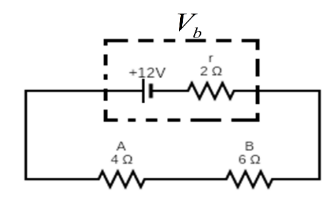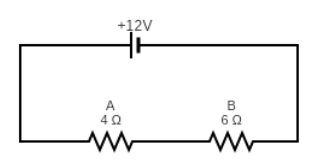
Answer
402k+ views
Hint: To solve this problem, use Ohm’s law for an electric circuit. Ohm’s law is given by, \[V = IR\] where, \[V\] is the voltage across any circuit element, \[I\] is the current through it, \[R\] is the resistance of the element. The energy dissipated per second from a circuit element of resistance \[R\] is given by, \[P = {I^2}R\], where \[I\] is the current through the resistance.
Complete step by step answer:
We know that Ohm's law for a circuit element in an electric circuit is given by, \[V = IR\]. Here, we have a battery of emf \[E = 12V\] with internal resistance \[r = 2\Omega \] is connected with two resistors \[{R_A} = 40\Omega \] and \[{R_B} = 60\Omega \]joined in series. So, circuits can also be drawn as follows.

(i) To find the current in the circuit at first we have to find the total resistance of the circuit.So, equivalent resistance of the circuit will be, \[{R_{eq}} = 4 + 6 + 2 = 10\] since all the resistances are connected in series. So, current through the circuit will be, \[I = \dfrac{E}{{{R_{eq}}}}\]
Putting values, we have, \[I = \dfrac{{12}}{{12}} = 1A\].
Hence, current through the circuit will be \[1A\].
(ii) We know that for an ideal cell/battery the terminal voltage is the same as the emf of the cell/battery but for a practical cell or battery the terminal voltage of a cell is the voltage across its terminals. Here, the battery has an internal resistance \[r = 2\Omega \] and that will lead to additional voltage drop across its terminals.So, the voltage drop due to the internal resistance is, \[V = Ir = 1 \times 2 = 2V\]
Hence, voltage across its terminal will be,
\[{V_b} = E - V\]
\[\therefore {V_b} = 12 - 2 = 10\,V\]
Hence, voltage across the terminal of the battery will be, \[10\,V\]
(iii) The potential difference across \[{R_B} = 6\,\Omega \]will be,
\[{V_B} = I{R_B} \]
$\Rightarrow {V_B}= 1 \times 6$
$\therefore {V_B}= 6\,V$
Hence, potential difference across \[6\,\Omega \] will be \[6\,V\]
(iv) We know that energy dissipated per second from a circuit element of resistance \[R\] is given by, \[P = {I^2}R\], where \[I\] is the current through the resistance. So, energy dissipated per minute through \[{R_A} = 4\Omega \] will be,
\[E = {I^2}R \times 60 \]
$\Rightarrow E = {1^2} \times 4 \times 60$
$\therefore E = 240\,J$
Hence, energy dissipated per minute through \[4\,\Omega \] resistance will be \[240\,J\] per minute.
Note: The maximum power transfer by a source is possible if the load is equal to the internal resistance of the source. Here, if we consider the \[4\,\Omega \] as the internal resistance of the battery along with \[2\,\Omega \] resistance then power transfer through the \[6\,\Omega \] resistance, taken as load, will be maximum.
Complete step by step answer:
We know that Ohm's law for a circuit element in an electric circuit is given by, \[V = IR\]. Here, we have a battery of emf \[E = 12V\] with internal resistance \[r = 2\Omega \] is connected with two resistors \[{R_A} = 40\Omega \] and \[{R_B} = 60\Omega \]joined in series. So, circuits can also be drawn as follows.

(i) To find the current in the circuit at first we have to find the total resistance of the circuit.So, equivalent resistance of the circuit will be, \[{R_{eq}} = 4 + 6 + 2 = 10\] since all the resistances are connected in series. So, current through the circuit will be, \[I = \dfrac{E}{{{R_{eq}}}}\]
Putting values, we have, \[I = \dfrac{{12}}{{12}} = 1A\].
Hence, current through the circuit will be \[1A\].
(ii) We know that for an ideal cell/battery the terminal voltage is the same as the emf of the cell/battery but for a practical cell or battery the terminal voltage of a cell is the voltage across its terminals. Here, the battery has an internal resistance \[r = 2\Omega \] and that will lead to additional voltage drop across its terminals.So, the voltage drop due to the internal resistance is, \[V = Ir = 1 \times 2 = 2V\]
Hence, voltage across its terminal will be,
\[{V_b} = E - V\]
\[\therefore {V_b} = 12 - 2 = 10\,V\]
Hence, voltage across the terminal of the battery will be, \[10\,V\]
(iii) The potential difference across \[{R_B} = 6\,\Omega \]will be,
\[{V_B} = I{R_B} \]
$\Rightarrow {V_B}= 1 \times 6$
$\therefore {V_B}= 6\,V$
Hence, potential difference across \[6\,\Omega \] will be \[6\,V\]
(iv) We know that energy dissipated per second from a circuit element of resistance \[R\] is given by, \[P = {I^2}R\], where \[I\] is the current through the resistance. So, energy dissipated per minute through \[{R_A} = 4\Omega \] will be,
\[E = {I^2}R \times 60 \]
$\Rightarrow E = {1^2} \times 4 \times 60$
$\therefore E = 240\,J$
Hence, energy dissipated per minute through \[4\,\Omega \] resistance will be \[240\,J\] per minute.
Note: The maximum power transfer by a source is possible if the load is equal to the internal resistance of the source. Here, if we consider the \[4\,\Omega \] as the internal resistance of the battery along with \[2\,\Omega \] resistance then power transfer through the \[6\,\Omega \] resistance, taken as load, will be maximum.
Recently Updated Pages
Identify the feminine gender noun from the given sentence class 10 english CBSE

Your club organized a blood donation camp in your city class 10 english CBSE

Choose the correct meaning of the idiomphrase from class 10 english CBSE

Identify the neuter gender noun from the given sentence class 10 english CBSE

Choose the word which best expresses the meaning of class 10 english CBSE

Choose the word which is closest to the opposite in class 10 english CBSE

Trending doubts
Fill the blanks with the suitable prepositions 1 The class 9 english CBSE

Which are the Top 10 Largest Countries of the World?

Change the following sentences into negative and interrogative class 10 english CBSE

Difference between Prokaryotic cell and Eukaryotic class 11 biology CBSE

10 examples of friction in our daily life

How do you graph the function fx 4x class 9 maths CBSE

Give 10 examples for herbs , shrubs , climbers , creepers

The Equation xxx + 2 is Satisfied when x is Equal to Class 10 Maths

What is pollution? How many types of pollution? Define it





